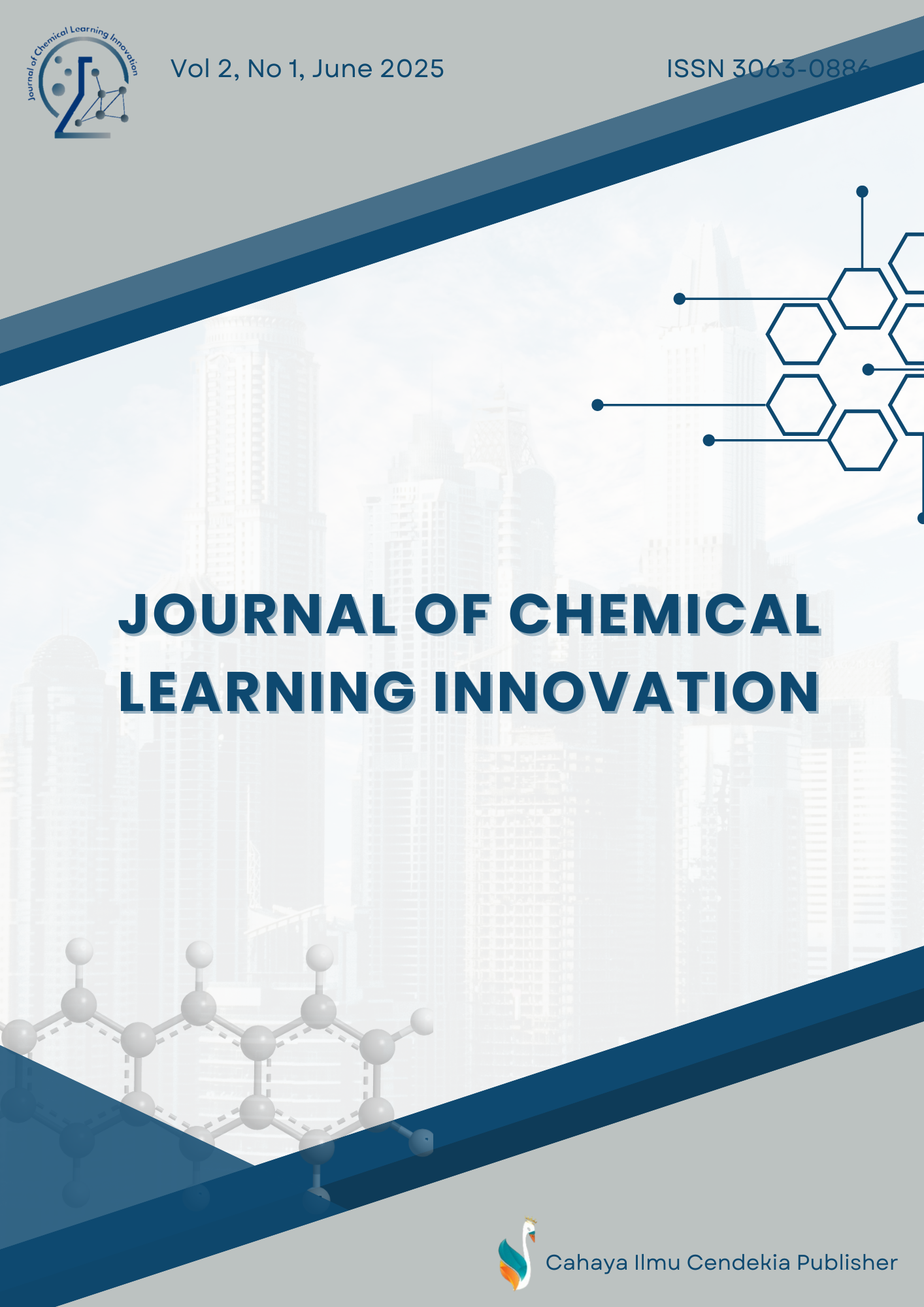Synthesis of SnO₂ Nanoparticles from Metals by Electrochemical Approach: An Innovative Solution for Functional Materials
Abstract
Purpose of the study: The aim of this study was to produce SnO2 nanoparticles by electrochemical method using tin metal and hydrochloric acid as electrolyte solution.
Methodology: Synthesis of SnO₂ nanoparticles was carried out using an electrochemical method with tin electrodes and HCl solution. Variations in potential (10–100 V) and HCl concentration (0.005–0.06 M) were observed for optimization. Characterization using UV-Vis, FTIR, XRD, and Zeta Sizer showed that this method was effective in producing SnO₂ nanoparticles with crystal structure, composition, and size distribution that could be optimized.
Main Findings: This study successfully synthesized SnO₂ nanoparticles from tin metal using an electrochemical method with HCl solution. The optimum potential for electrolysis was 60 V, with a HCl concentration of 0.06 M producing the largest nanoparticles (83.11 nm) at a wavelength of 207 nm and an absorbance of 3.068. XRD characterization showed a diffraction pattern according to the SnO₂ standard, while FTIR confirmed the Sn–O vibration at 580 cm⁻¹.
Novelty/Originality of this study: The characterization results show a correlation between HCl concentration with nanoparticle size and absorbance wavelength, which provides new insights into controlling the optical properties and structure of SnO₂ nanoparticles.
References
Y. Khan et al., “Nanoparticles , and Their Applications in Various Fields of Nanotechnology : A Review,” Catalysts, vol. 12, no. 11, p. 1386, 2022.
U. Ulusoy, “A Review of Particle Shape Effects on Material Properties for Various Engineering Applications: From Macro to Nanoscale,” Minerals, vol. 13, no. 1, pp. 1–81, 2023, doi: 10.3390/min13010091.
M. Ramesh, R. Janani, C. Deepa, and L. Rajeshkumar, “Nanotechnology-Enabled Biosensors : A Review of Fundamentals ,” Biosensors, vol. 13, no. 40, pp. 1–32, 2023.
M. N. Ayub et al., “Modern innovations in the provision and efficient application of 2D inorganic nanoscale materials,” Rev. Inorg. Chem., vol. 45, no. 1, pp. 175–206, 2024, doi: 10.1515/revic-2023-0036.
L. Pokrajac et al., “Nanotechnology for a Sustainable Future: Addressing Global Challenges with the International Network4Sustainable Nanotechnology,” ACS Nano, vol. 15, no. 12, pp. 18608–18623, 2021, doi: 10.1021/acsnano.1c10919.
K. Eskandar, “Revolutionizing biotechnology and bioengineering: unleashing the power of innovation,” J. Appl. Biotechnol. Bioeng., vol. 10, no. 3, pp. 81–88, 2023, doi: 10.15406/jabb.2023.10.00332.
V. Harish et al., “Cutting-edge advances in tailoring size, shape, and functionality of nanoparticles and nanostructures: A review,” J. Taiwan Inst. Chem. Eng., vol. 149, no. March, p. 105010, 2023, doi: 10.1016/j.jtice.2023.105010.
F. T. Z. Toma, M. S. Rahman, and K. H. Maria, “A review of recent advances in ZnO nanostructured thin films by various deposition techniques,” 2025, Springer International Publishing. doi: 10.1007/s43939-025-00201-1.
S. J. Salih and W. M. Mahmood, “Review on magnetic spinel ferrite (MFe2O4) nanoparticles: From synthesis to application,” Heliyon, vol. 9, no. 6, pp. 1–25, 2023, doi: 10.1016/j.heliyon.2023.e16601.
B. Mekuye and B. Abera, “Nanomaterials: An overview of synthesis, classification, characterization, and applications,” Nano Sel., vol. 4, no. 8, pp. 486–501, 2023, doi: 10.1002/nano.202300038.
M. Gaur et al., “Biomedical applications of carbon nanomaterials: Fullerenes, quantum dots, nanotubes, nanofibers, and graphene,” Materials (Basel)., vol. 14, no. 20, pp. 1–35, 2021, doi: 10.3390/ma14205978.
Paras et al., “A Review on Low-Dimensional Nanomaterials: Nanofabrication, Characterization and Applications,” Nanomaterials, vol. 13, no. 1, pp. 1–44, 2023, doi: 10.3390/nano13010160.
K. Li et al., “Alignment of Cellulose Nano fi bers :,” ACS Nano, vol. 15, pp. 3646–3673, 2021.
S. Fan, Y. Chen, J. Wu, S. Xiao, G. Chen, and P. K. Chu, “Structure, superlubricity, applications, and chemical vapor deposition methods of graphene solid lubricants,” Tribol. Int., vol. 198, no. December 2023, pp. 1–21, 2024, doi: 10.1016/j.triboint.2024.109896.
Z. Zhu, Y. Zhou, Z. Huang, Z. Wang, and Y. Chen, “Mechanical Properties Evaluation of Polymer-Binding C-S-H Structure from Nanoscale to Macroscale: Hydroxyl-Terminated Polydimethylsiloxane (PDMS) Modified C-S-H,” Materials (Basel)., vol. 15, no. 23, pp. 1–16, 2022, doi: 10.3390/ma15238361.
K. Hachem et al., “Methods of Chemical Synthesis in the Synthesis of Nanomaterial and Nanoparticles by the Chemical Deposition Method: A Review,” Bionanoscience, vol. 12, no. 3, pp. 1032–1057, 2022, doi: 10.1007/s12668-022-00996-w.
A. Barhoum et al., “Review on Natural, Incidental, Bioinspired, and Engineered Nanomaterials: History, Definitions, Classifications, Synthesis, Properties, Market, Toxicities, Risks, and Regulations,” Nanomaterials, vol. 12, no. 2, 2022, doi: 10.3390/nano12020177.
S. Barage et al., “Nanomaterial in Food Packaging: A Comprehensive Review,” J. Nanomater., vol. 2022, pp. 1–12, 2022, doi: 10.1155/2022/6053922.
G. K. Dalapati et al., “Tin oxide for optoelectronic, photovoltaic and energy storage devices: A review,” J. Mater. Chem. A, vol. 9, no. 31, pp. 16621–16684, 2021, doi: 10.1039/d1ta01291f.
A. H. Pinto et al., “Doped Tin Dioxide (d-SnO2) and Its Nanostructures: Review of the Theoretical Aspects, Photocatalytic and Biomedical Applications,” Solids, vol. 3, no. 2, pp. 327–360, 2022, doi: 10.3390/solids3020024.
A. J. Albarakati and I. A. Matter, “N-Type Metal Oxide Semiconductor: Materials and Their Environmental Applications,” Biointerface Res. Appl. Chem., vol. 13, no. 6, pp. 1–23, 2023, doi: 10.33263/BRIAC136.519.
Y. T. Gebreslassie and H. G. Gebretnsae, “Green and Cost-Effective Synthesis of Tin Oxide Nanoparticles: A Review on the Synthesis Methodologies, Mechanism of Formation, and Their Potential Applications,” Nanoscale Res. Lett., vol. 16, no. 1, pp. 1–16, 2021, doi: 10.1186/s11671-021-03555-6.
T. Li et al., “The Combination of Two-Dimensional Nanomaterials with Metal Oxide Nanoparticles for Gas Sensors: A Review,” Nanomaterials, vol. 12, no. 6, pp. 1–40, 2022, doi: 10.3390/nano12060982.
A. K. Ganguli, G. B. Kunde, W. Raza, S. Kumar, and P. Yadav, “Assessment of Performance of Photocatalytic Nanostructured Materials with Varied Morphology Based on Reaction Conditions,” Molecules, vol. 27, no. 22, pp. 1–37, 2022, doi: 10.3390/molecules27227778.
M. Parashar, V. K. Shukla, and R. Singh, “Metal oxides nanoparticles via sol–gel method: a review on synthesis, characterization and applications,” J. Mater. Sci. Mater. Electron., vol. 31, no. 5, pp. 3729–3749, 2020, doi: 10.1007/s10854-020-02994-8.
V. Y. Kumkale et al., “Synthesis of Tin Oxide Nanoparticles using Microwave-Assisted Method for Dye-Sensitized Solar Cell Application,” ES Energy Environ., vol. 23, pp. 1–11, 2024, doi: 10.30919/esee1104.
M. Schlenkrich and S. N. Parragh, “Solving large scale industrial production scheduling problems with complex constraints: an overview of the state-of-the-art,” Procedia Comput. Sci., vol. 217, no. 2022, pp. 1028–1037, 2022, doi: 10.1016/j.procs.2022.12.301.
A. J. Watson, W. Lu, M. H. D. Guimaraes, and M. Stöhr, “Transfer of large-scale two-dimensional semiconductors: Challenges and developments,” 2D Mater., vol. 8, no. 3, pp. 1–28, 2021, doi: 10.1088/2053-1583/abf234.
U. D. Babar et al., “Antimony-modified tin oxide nanoparticles: hydrothermal synthesis for high-performance supercapacitor electrodes,” Carbon Lett., pp. 1–14, 2025.
P. S. Jassal, D. Kaur, R. Prasad, and J. Singh, “Green synthesis of titanium dioxide nanoparticles: Development and applications,” J. Agric. Food Res., vol. 10, no. August, p. 100361, 2022, doi: 10.1016/j.jafr.2022.100361.
P. Bélteky et al., “Are smaller nanoparticles always better? Understanding the biological effect of size-dependent silver nanoparticle aggregation under biorelevant conditions,” Int. J. Nanomedicine, vol. 16, pp. 3021–3040, 2021, doi: 10.2147/IJN.S304138.
K. A. Altammar, “A review on nanoparticles: characteristics, synthesis, applications, and challenges,” Front. Microbiol., vol. 14, no. April, pp. 1–20, 2023, doi: 10.3389/fmicb.2023.1155622.
G. Habibullah, J. Viktorova, and T. Ruml, “Current Strategies for Noble Metal Nanoparticle Synthesis,” Nanoscale Res. Lett., vol. 16, no. 1, pp. 1–12, 2021, doi: 10.1186/s11671-021-03480-8.
P. Phogat, R. Jha, and S. Singh, “Harnessing ZnO morphologies in energy application and sustainable development,” Phys. Scr., vol. 99, no. 10, p. 102004, 2024.
A. Pujara, R. Sharma, N. Samriti, M. Bechelany, Y. K. Mishra, and J. Prakash, “Novel zinc oxide 3D tetrapod nano-microstructures: recent progress in synthesis, modification and tailoring of optical properties for photocatalytic applications,” Mater. Adv., vol. 6, pp. 2123–2153, 2025, doi: 10.1039/d4ma01272k.
R. H. Althomali and W. A. Adeosun, “Wet chemically synthesized metal oxides nanoparticles, characterization and application in electrochemical energy storage: An updated review,” Synth. Met., vol. 298, p. 117424, 2023.
E. Fazio et al., “Metal-Oxide Based Nanomaterials: Synthesis, Characterization and Their Applications in Electrical and Electrochemical Sensors,” Sensors, vol. 21, pp. 1–32, 2021, doi: 10.3390/ s21072494.
N. Hossain et al., “Advances and significances of nanoparticles in semiconductor applications – A review,” Results Eng., vol. 19, no. August, p. 101347, 2023, doi: 10.1016/j.rineng.2023.101347.
Y. Lin et al., “Application-driven high-thermal-conductivity polymer nanocomposites,” ACS Nano, vol. 18, no. 5, pp. 3851–3870, 2024.
D. J. Pochapski, C. Carvalho Dos Santos, G. W. Leite, S. H. Pulcinelli, and C. V. Santilli, “Zeta Potential and Colloidal Stability Predictions for Inorganic Nanoparticle Dispersions: Effects of Experimental Conditions and Electrokinetic Models on the Interpretation of Results,” Langmuir, vol. 37, no. 45, pp. 13379–13389, 2021, doi: 10.1021/acs.langmuir.1c02056.
G. Battaglia et al., “Analysis of particles size distributions in Mg(OH)2 precipitation from highly concentrated MgCl2 solutions,” Powder Technol., vol. 398, p. 117106, 2022, doi: 10.1016/j.powtec.2021.117106.
L. Leng et al., “An overview on engineering the surface area and porosity of biochar,” Sci. Total Environ., vol. 763, p. 144204, 2021.
A. M and P. K. G, “Hydrogen towards sustainable transition: A review of production, economic, environmental impact and scaling factors,” Results Eng., vol. 20, no. August, p. 101456, 2023, doi: 10.1016/j.rineng.2023.101456.
A. Lahrichi, Y. El Issmaeli, S. S. Kalanur, and B. G. Pollet, “Advancements, strategies, and prospects of solid oxide electrolysis cells (SOECs): Towards enhanced performance and large-scale sustainable hydrogen production,” J. Energy Chem., vol. 94, no. March, pp. 688–715, 2024, doi: 10.1016/j.jechem.2024.03.020.
Copyright (c) 2025 Rahmi Rahmi, Tom Downs, Malësore Pllana-Zeqiri

This work is licensed under a Creative Commons Attribution 4.0 International License.
Authors who publish with this journal agree to the following terms:
- Authors retain copyright and acknowledge that the Journal of Chemical Learning Innovation is the first publisher licensed under a Creative Commons Attribution 4.0 International License.
- Authors are able to enter into separate, additional contractual arrangements for the non-exclusive distribution of the journal's published version of the work (e.g., post it to an institutional repository or publish it in a book), with an acknowledgment of its initial publication in this journal.
- Authors are permitted and encouraged to post their work online (e.g., in institutional repositories or on their website) prior to and during the submission process, as it can lead to productive exchanges and earlier and greater citation of published work.





.png)
.png)










